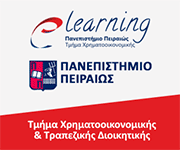Decision Making Theory
Course Name: Decision Making Theory
Teacher: Nikitas Pittis
School: Finance and Statistics
Department: Banking and Financial Management
Level: Undergraduate
Course ID: — Semester: 5th and 7th
Course Type: Elective Course
Prerequisites: –
Teaching and Exams Language: Greek
Course Availability to Erasmus Students: No
Course webpage: –
Specific Teaching Activities |
Weekly Teaching Hours |
Credit Units |
Lectures |
4 |
6 |
Course Content
The aim of this course is threefold: First, to introduce the basic ingredients in a typical decision making problem under uncertainty. The course begins with many practical examples, which clarify the nature of the problem.
Second, to analyse the decision making problem under conditions of risk. This is the classical Von Neumann – Morgenstern framework in which the probabilities of the various outcomes are objective and known to the decision maker. In this setting, the objects of choice are the so-called “lotteries”, that is probability distributions. The main representation theorem is introduced which shows the conditions under which a preference relation defined on the space of lotteries is represented by a utility function, along with the principle of expected utility maximization.
Third, to analyze the decision making problem under conditions of uncertainty. This is the case in which the decision maker does not know the probabilities of the various outcomes. In such a case, he has to employ his own personal or subjective probabilities. This framework, introduced by Savage, also results in a representation theorem in which the preference relation defined on the set of actions is represented by a pair of functions, a utility function and a probability function.
This course is instrumental for students who wish to follow post-graduate studies in fields of economic theory, such as microeconomic theory or finance theory.
After the successful completion of this course, the students will be able to:
- Formulate a decision-making problem in its standard form in order to solve it using the standard methods
- Distinguish between cases of risk and uncertainty, so that they choose the appropriate method for solving the corresponding decision making problem
- Obtain the necessary theoretical background, for attending post-graduate studies in Microeconomic and Finance Theory
- Apply the theoretical results to practical problems in their work.
Teaching Results
Skills
Teaching and Learning Methods - Evaluation
Lecture: Ιn Class
Use of Information and Communication Technologies: —
Teaching Analysis:
Activity |
Semester Workload |
Lectures |
52 |
Study |
98 |
Total |
150 |
Student Evaluation:




